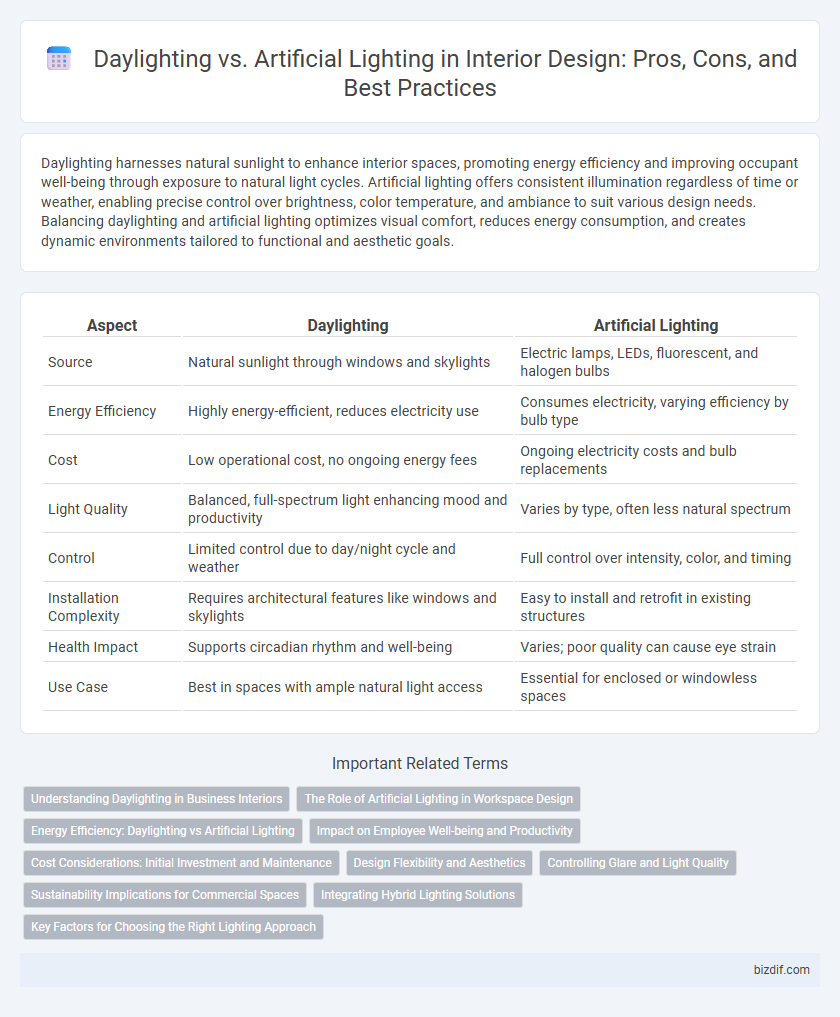Daylighting harnesses natural sunlight to enhance interior spaces, promoting energy efficiency and improving occupant well-being through exposure to natural light cycles. Artificial lighting offers consistent illumination regardless of time or weather, enabling precise control over brightness, color temperature, and ambiance to suit various design needs. Balancing daylighting and artificial lighting optimizes visual comfort, reduces energy consumption, and creates dynamic environments tailored to functional and aesthetic goals.
Table of Comparison
| Aspect | Daylighting | Artificial Lighting |
|---|---|---|
| Source | Natural sunlight through windows and skylights | Electric lamps, LEDs, fluorescent, and halogen bulbs |
| Energy Efficiency | Highly energy-efficient, reduces electricity use | Consumes electricity, varying efficiency by bulb type |
| Cost | Low operational cost, no ongoing energy fees | Ongoing electricity costs and bulb replacements |
| Light Quality | Balanced, full-spectrum light enhancing mood and productivity | Varies by type, often less natural spectrum |
| Control | Limited control due to day/night cycle and weather | Full control over intensity, color, and timing |
| Installation Complexity | Requires architectural features like windows and skylights | Easy to install and retrofit in existing structures |
| Health Impact | Supports circadian rhythm and well-being | Varies; poor quality can cause eye strain |
| Use Case | Best in spaces with ample natural light access | Essential for enclosed or windowless spaces |
Understanding Daylighting in Business Interiors
Daylighting in business interiors leverages natural sunlight to enhance visual comfort, reduce energy consumption, and improve occupant well-being. Strategic placement of windows, skylights, and light shelves maximizes daylight penetration while minimizing glare and heat gain. Effective daylighting design not only lowers operational costs but also boosts productivity and creates a sustainable workspace environment.
The Role of Artificial Lighting in Workspace Design
Artificial lighting plays a crucial role in workspace design by providing consistent illumination levels that enhance productivity and reduce eye strain regardless of natural light availability. Advanced lighting systems, including LED fixtures with adjustable color temperature and intensity, support circadian rhythms and improve employee well-being. Integrating artificial lighting strategically also ensures compliance with occupational health standards and creates an environment conducive to focus and creativity.
Energy Efficiency: Daylighting vs Artificial Lighting
Daylighting significantly enhances energy efficiency by utilizing natural sunlight, reducing the need for electrical lighting during daytime hours and lowering energy consumption. In contrast, artificial lighting relies on electricity, often increasing energy costs and carbon emissions, especially when inefficient bulbs are used. Integrating daylighting strategies such as skylights, light shelves, and large windows optimizes natural light distribution, maximizing energy savings in interior design projects.
Impact on Employee Well-being and Productivity
Daylighting enhances employee well-being by regulating circadian rhythms, reducing eye strain, and boosting mood and alertness, which directly improves productivity levels. Artificial lighting, when properly designed with adjustable brightness and color temperature, can support task performance but often lacks the natural benefits of sunlight exposure. Integrating balanced daylighting with ergonomic artificial lighting optimizes work environments, leading to higher employee satisfaction and sustained productivity.
Cost Considerations: Initial Investment and Maintenance
Daylighting reduces long-term energy expenses by utilizing natural sunlight, minimizing reliance on electric lighting and lowering utility bills. Initial investment for daylighting involves costs related to architectural modifications like window installation and light shelves, which can be higher than purchasing artificial lighting fixtures. Maintenance costs for daylighting are generally lower, as natural light requires minimal upkeep compared to the periodic bulb replacements and electrical system maintenance associated with artificial lighting.
Design Flexibility and Aesthetics
Daylighting offers dynamic design flexibility by adapting to natural light patterns, enhancing interior aesthetics with changing shadows and color tones throughout the day. Artificial lighting provides consistent illumination, allowing designers to precisely control mood and ambiance regardless of time or weather conditions. Combining both methods maximizes aesthetic appeal while optimizing spatial functionality and energy efficiency.
Controlling Glare and Light Quality
Controlling glare in interior design requires balancing daylighting and artificial lighting to optimize visual comfort and maintain high light quality. Daylighting contributes to natural light quality but can cause intense glare if not properly managed using shading devices, diffusers, or smart glass. Artificial lighting offers precise control over brightness and color temperature, enhancing uniformity and reducing glare through adjustable fixtures and dimmers.
Sustainability Implications for Commercial Spaces
Daylighting in commercial spaces harnesses natural sunlight to reduce energy consumption, lowering carbon footprints and operational costs. Artificial lighting, while customizable, often demands higher electricity use and may contribute to increased greenhouse gas emissions if not sourced from renewable energy. Integrating advanced daylighting controls with energy-efficient artificial systems creates a sustainable lighting strategy that enhances occupant well-being while minimizing environmental impact.
Integrating Hybrid Lighting Solutions
Integrating hybrid lighting solutions combines the energy efficiency and natural ambiance of daylighting with the reliability and control of artificial lighting, optimizing visual comfort and productivity in interior spaces. Advanced sensors and automated controls adjust artificial illumination based on available daylight, significantly reducing energy consumption while maintaining consistent lighting levels. This synergy enhances aesthetic appeal, supports circadian rhythms, and promotes sustainable interior design practices.
Key Factors for Choosing the Right Lighting Approach
Daylighting enhances interior spaces by maximizing natural light, reducing energy consumption, and promoting well-being, making it ideal for areas with ample sunlight exposure. Artificial lighting offers controlled illumination levels, color temperature customization, and flexibility, crucial for spaces with limited natural light or specific functional needs. Key factors for selecting the right lighting approach include the room's orientation, purpose, occupant preferences, energy efficiency goals, and the integration of lighting controls and architectural elements.
Daylighting vs Artificial Lighting Infographic

 bizdif.com
bizdif.com